Area Information
Costa de Almería
Mojacar Pueblo
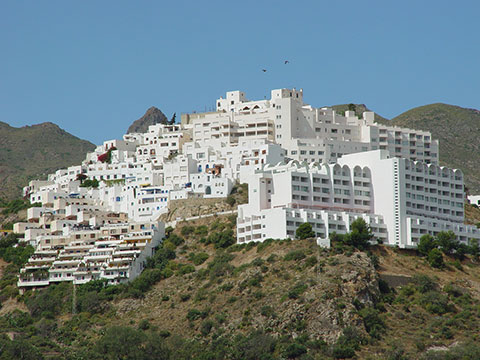
Mojacar, with its hill-top village and beach resort offers both history & romance and space for relaxation and recreation.
Mojacar Pueblo (Town) is a picturesque sight of whitewashed buildings and steep and winding, cobbled streets. Perched high on a hill in the Sierra Cabrera it overlooks the Mediterranean Sea. It was a centre of trade for the Phoenicians, Greeks and Romans but the Moorish influence dating from the 8th Century, is most visible.
The place is a melting pot of cultures, indeed, it is said to have proportionately one of the most international blend of people in Spain. It is also a haven to people with an interest in the arts, many writers, painters and photographers have made Mojacar their home. Moreover, it is a very popular tourist destination thanks to its unique charm, relaxed atmosphere and warm hospitality.
There are variety of interesting boutiques and shops to tempt you or why not relax and have a beer or two in the many excellent bars and street cafes. Every Wednesday is market day and the streets are home to numerous stalls selling essentials to the locals.
There are a number of historical places of interest in Mojacar:
- La Fuente (Fountain), where women used to wash clothes with their feet in the water. Natural spring water is said to have flowed here since the Roman times. It was restored in 1876.
- The Plaza Nueva with its splendid views of the neighbouring countryside. It also houses the Hermitage de los Dolores which is now a shop.
- The Parish Church de Santa Maria, which looks like a fortress; it has a single vaulted nave and was begun in 1560.
- The ancient Castillo which dominates the village and is now an open viewing platform.
- Casa del Torrein, the old customs house.
- Puerta de la Ciudad (City Gate), a semi-circular arch featuring the arms of the town. It is the original site of the main entrance to the village since Moorish times.
One of the strangest tales associated with Mojacar is that it is the birthplace of Walt Disney. Apparently, Walt was the illegitimate son of a local woman who emigrated to the USA. In Chicago she is said to given him up for adoption to Flora and Elias Disney. Sadly, this anecdote cannot be confirmed as no birth records exist in either town.
Each June, for 3 days, there is a Moors and Christians festival, that celebrates the expulsion of the Moors from the region. It is a spectacle well worth seeing, there are re-enactments of key events and the participants dress in elaborate costumes. Every year the two groups stage mock battles urged on by the crowd, and true to history the Christians emerge victorious. This takes place against a background of music and gunpowder explosions.
The symbol of Mojacar is the Indalo Man, the shape of a man holding an arc between his outstretched arms. It is said it brings protection and good luck and is often painted on the front of houses. The symbol is thought to be 4500 years old and is associated with the Neolithic paintings found in the caves of Velez Blanco.
Mojacar Playa
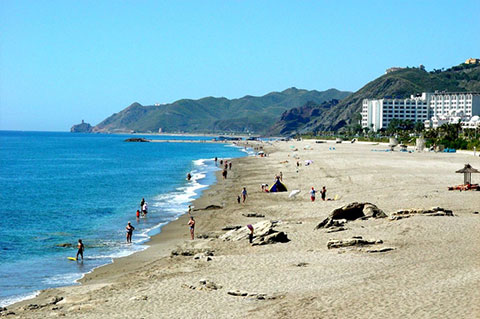
Just 2 km away from the Mojacar Pueblo is its beach resort. The long uncrowded sandy beaches are one of its main attractions.
The beaches are 17 km long, with a large part being designated an area of natural beauty. Only 7 km have been developed and they consistently earn European Blue Flag awards for cleanliness.
The beach resort has been developed over the past two decades, it is now a lively resort with much to offer with beach bars, local and international restaurants, discos, hotels and shops. The resort enforces a building restriction to prevent it becoming a high rise concrete development; residential buildings are restricted to two storeys and hotels can't be built higher than four floors.
For those looking for an active holiday there is much to do. There is a full range of watersports including jet ski-ing, canoeing, water ski-ing, sailing, windsurfing and scuba diving. If you have a head for heights why not take a flight in a microlight over the beach at the Indalo Wings Microlight Centre or try your hand at paragliding. When you have done all this there is still hiking, rock climbing, biking or horse riding.
There is an 18 hole golf course at Marina de la Torre that offers spectacular views of the coast, whilst enjoying a challenging round of golf.
For a spot of retail therapy try the Parque Comercial, a modern shopping precinct at the intersection of the sea front and the road to Mojacar Pueblo.
There is a local bus service that runs regularly between the beach and the Mojacar Pueblo.
Garrucha
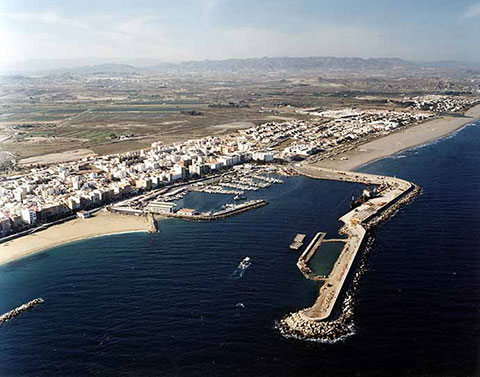
Garrucha is a beautiful and lively fishing town that still retains much of its original charm. Over the last few years it has become a popular tourist destination. Its tourist slogan is "Garrucha, Sun and Seafood"; the town is famous for the quality of its large red prawns, only fished in the local waters. Garrucha has a strong fishing industry, its main source of income, with a large port for both commercial and leisure pursuits.
Garrucha has a great selection of restaurants and bars with many excellent seafood restaurants found along the seafront serving the fresh catch of the day. They are supplied with fresh fish from nearby port, if you find yourself down on the seafront at dawn you will experience the typically Mediterranean sight of a flotilla of small fishing boats setting out to sea. Later the fishermen host a daily fish auction each afternoon at a quayside fish market.
Two buildings of interest in Garrucha are the Parish Church de San Joaquin and the Hermitage de la Virgen del Carmen, the patron saint of Garrucha. Every year on the 16th July the fishermen pass the chapel on their way to the sea in a spirited procession.
One of the pleasures of Garrucha is taking a lovely evening stroll around the bay. A palm tree lined promenade framed by white marble balustrades spans the length of the town, almost 2km. There are landscaped areas to sit and relax whilst watching the sunset over the Mediterranean sea and delightful play areas for the children. A stroll along here takes in three successive ports of Garrucha the sports port, fishing port and the commercial port
Garrucha is well known for its magnificent, golden sandy beaches, stretching as far as the eye can see, for several kilometres. The beach opposite the town centre is the only blue flag in town beach in Europe. As you continue past Garrucha there are a series of superb recently developed beaches, covering 8km.
Villaricos
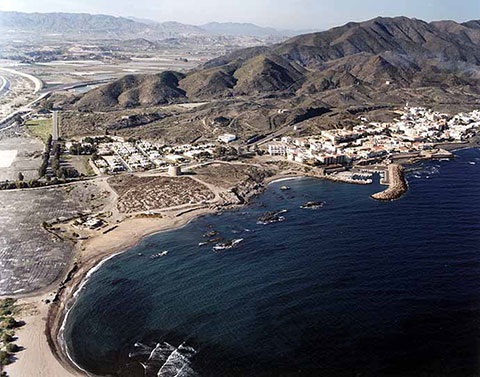
Follow the coast road north from Garrucha for about 10km and you find the small, quaint town of Villarícos, a lively fishing harbour in the process of development with villas, hostels and hotels, as well as some fine seafront fish restaurants. Market day is Sunday!
Villarícos is situated in a unique position on the mouth of the Rio Almanzora and the coast. There is a strong fishing community here, as well as several unspoiled beaches. The surrounding countryside is stunning with the entire stretch of coastline sheltered by the dramatic Sierra Almagrera mountain offering great views and private beaches in both directions.
Nearby is the truly stunning international golf resort of Desert Springs and more golf lies to the north in the picturesque beachside town of San Juan de los Terreros. This quaint town has some superb beach bars and a real Spanish way of life although it can become very quiet in the winter months.
San Juan de los Terreros
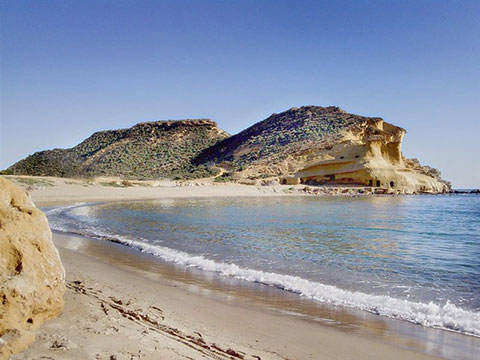
Near to the border of Andalucia with Murcia lies San Juan de los Terreros. The beach is famous in the area because it shelves gently making it safer for families than many of the other beaches along this coast. Just to the north there are some delightful coves and inlets, which also feature sandy beaches and shallow waters.
San Juan de los Terreros has been developed over the last few years and now there is plenty of accommodation for holidaymakers, whether they require hotels or apartments to rent. There are all the facilities that you would expect, including a new esplanade which has been attractively laid out with clumps of palm trees near the centre of the village. Nice looking wooden beach bars have been erected and there are some good restaurants and bars.
The Castle was constructed in the 1764 in the style of a coastal fort on a headland 150 metres high that stretches out into the sea, and has been declared to be of Cultural Interest. The Castle is accessible via a steep narrow road, but is worth the walk, as from here on a clear day you have splendid views up the coast as far as Cabo Cope and down the coast to the Castle of Roldán in Carboneras. Just out to sea lie two islands; Isla Negra and Isla de Terreros, both of which have been declared as natural parkland and therefore protected.
San Juan de los Terreros, is only 8 kilometres from the busy fishing port of Aguilas and just 12 kilometres from Pulpi, the capital of the municipality to which San Juan de los Terreros belongs.
Although much quieter in the winter months, many people from northern Europe own property here and it is not unusual to see them enjoying the lovely beach and the warm shallow waters right into November.
The sharp, jagged peaks of the mountains behind the resort frame the skyline as the sun goes down and if you are tempted to climb them, you are rewarded with lovely views over the plain sweeping towards Huercal Overa and miles of lovely coastline. In Pilar de Jaravía, at the base of the Sierra del Aguilón and just a few kilometres inland there is a palm tree grove which gives the place an air of an oasis.
Further into the mountains there are old iron and silver mines, and a stiff uphill walk is worthwhile in order to see the old workings and ruined villages where the miners lived.
Park natural Cabo de Gata-Nijar
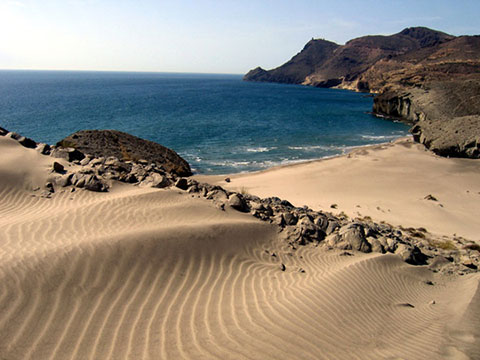
Cabo de Gata, still a small fishing village, is now a popular tourist destination in the summer months.
Historically, there are two buildings of merit in Cabo de Gata: the Torre de San Miguel (Tower of Saint Michael) erected in 1756 during the reign of King Ferdinand VI and the Parish Church de La Virgen del Mar, built in 19th Century.
A stroll along the Maritime Avenue is a lovely way to appreciate the beaches. The volcanic mountain range of Cabo de Gata with its sharp peaks and crags provided a dramatic backdrop.
The long, straight beach to the east of Cabo de Gata is a popular hotspot during the summer weekends with the Spanish. Along the coastal road are salt flats. The salt works of Cabo de Gata are still in use. The plant consists of 300 submerged hectares divided by a spit and is the principal wetland of the Almerian coast. It has a significant permanent bird population, including pink flamingos and ornithologists will appreciate the local bird observatory.
A visit to the nearby Cabo de Gata Natural Park is a must. It is Andalucia's largest coastal nature park. The park covers some 38,000 hectares of land and another 12,000 hectares under water. It is an area of unspoilt beauty with unique scenery, volcanic craters, rocky headlands and sandy coves. Apart from walking and enjoying the scenery there is much for the visitor to do including water-sports, cycling and climbing.
Costa Calida
Costa Calida
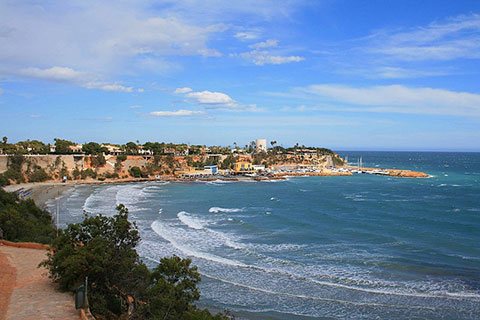
Two seas on one coastline - the Mar Menor and the Mediterranean - , impressive cliffs, heavenly beaches of endless white sand, lively ports and wild beaches with crystal clear water, more than 3,000 hours of sun a year and mild temperatures - even in winter - with a yearly average of more than 18ºC. This is the Costa Cálida, the ideal place to spend some days relaxing both in winter and summer.
From the fishing town of Águilas to the white dunes of the beach of El Mojón in San Pedro del Pinatar, stretch kilometre after kilometre of beaches, some of them completely deserted, awaiting the arrival of the bather, the sailor, the diver or the fisherman. In addition, there are delightful picturesque fishing villages, like La Azohia or Cabo de Palos where you can lose yourself for a few days; ports like the one in Mazarrón where you can spend a lively evening and enjoy its magnificent gastronomy after a day on the beach; heavenly areas of natural beauty, unique in the whole Mediterranean, at the beaches of Calblanque and Calnegre... and one of the most highly considered tourist complexes in the Mediterranean: La Manga del Mar Menor, a paradise between two seas with infinite beaches, sandy sea beds and crystalline waters, and endowed with an excellent hotel infrastructure.
Furthermore, fans of water sports will find one of the best places in the world for practising sailing, canoeing, swimming, water-skiing, jet-skiing, flysurfing, windsurfing, catamaranning, and every other type of watersport activity in its numerous clubs, ports and sailing schools. The Nautical Resort on the Mar Menor and similar consortiums in Mazarrón and Águilas offer the chance to hire out equipment, book sailing courses and reserve accommodation at extremely interesting rates.

